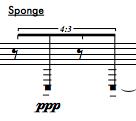Nicolai Worsaae
Epilogus I “Organum”
(2013)
for amplified piano quartet
Dur. c. 6′
NOTES
The epilogue is known from theatre as the concluding monologue, which gathers the play’s threads and outlines the main character’s crucial problem. It is a short segment with a clear intention of rounding off the play. But probably also leave a window open for new beginnings? It was this short and precise form that I became interested in as starting point for my work Epilogus I for piano quartet.
I had been fascinated by Lars von Trier’s TV series Riget (“The Kingdom”) for a long time and the way he stepped forward in front of the stage curtain after each episode to comment on the story. He did this with an ironic distance to the experience he had just given us. This was in a classical sense an epilogue, but the purpose was to turn the perception of what just happened up side down. This way he allowed the viewer to doubt the truthfulness of the artwork. It may have been very typical of the 1990s with irony and to distance oneself to everything. Nevertheless it had a refreshing effect, which punctuated the self-importance that can encircle a work.
In a lot of ways I seek the same intentions as von Trier. To turn everything up side down by allowing the ending to be the beginning and the beginning to be the ending. In many cases the beginning and the ending are very similar. Not least the theory about the Big Bang. I took the ending of a former work and used it as the beginning or starting point for the new one. The beginning is characterised by noise interference and faint scratchy sounds that worm in and out of each other like in a wirework. Slowly it develops and the surfaces move closer to each other and are soon replaced by more articulated rhythmical repetitive noise modules. And suddenly out of the blue an organ movement by Perotin from the late Middle Ages starts to play. It is not only a contrast to the noise’s unclear scene, but also has a symbolic meaning as representative of the earliest European polyphony and thus a kind of beginning, which now acts as an ending. Perhaps it has metaphorically been scratched up from the surface of the noise, perhaps it has just appeared out of nowhere. The fact is that it changes the work completely. First the quoted music appears instrumentally, but later the performers also sing it. Only the pianist continues to be situated in this scratchy and scraping noise sound universe and lies as a stubborn persistent layer underneath the old Middle Ages music right till the end.
NOTER
Epilogen er kendt fra skuespillet som den afsluttende monolog, der samler stykkets tråde eller opridser hovedpersonens problemstilling. Den er et kort formled med en klar intention om at runde af. Men muligvis også lade visse ting stå åbne til nye begyndelser? Det var denne korte og præcise form jeg blev interesseret i som udgangspunkt for mit værk Epilogus I for klaverkvartet.
Jeg var længe fascineret af Lars von Triers tv-serie Riget og den måde han efter afsnittene selv trådte frem foran scenetæppet for at kommentere på handlingen. Dette gjorde han med en ironisk distance til den oplevelse han lige havde givet os. Det var i klassisk forstand en epilog, men hvor formålet var at vende op og ned på opfattelsen af det der var sket. Dermed lod han tvivlen om kunstværkets sandfærdighed komme ind. Muligvis var det meget tidstypisk for 1990’erne med ironi og distance til alting. Ikke desto mindre havde det en forfriskende effekt som punkterede selvhøjtideligheden der kan omkranse et værk.
På mange måder søger jeg mod de samme intentioner som hos von Trier. At vende det hele på hovedet ved at lade enden være begyndelsen og begyndelsen være enden. I mange tilfælde har begyndelsen og enden store lighedstræk. Ikke mindst i teorien om The big bang. Jeg tog slutningen fra et tidligere værk og lod det være begyndelsen eller udgangspunktet for det nye. Starten er præget af støjflader og svage kradsende lyde, der snor sig ind og ud af hinanden som i et trådværk. Langsomt udvikles det og fladerne nærmer sig hinanden og afløses snart af mere artikulerede rytmiske repetitive støjmoduler. Og pludselig ud af det blå begynder denne senmiddelalder organumsats af Perotin at klinge. Den er ikke bare kontrast til støjens uklare billede, men får også en symbolsk betydning som repræsentant for den tidligste europæiske flerstemmighed og dermed en slags begyndelse, der nu optræder som slutning. Måske er den billedligt skrabet frem af støjens overflade måske er den bare kommet ud af ingenting. Faktum er at den ændrer værket fuldstændig. Den citerede musik optræder først instrumentalt men bliver sidenhen også sunget af de udøvende. Kun pianisten fortsætter med at befinde sig i dette kradsende og skrabende støjlydsunivers og ligger som et stædigt vedblivende lag under den gamle middelaldermusik helt indtil slutningen.
Nicolai Worsaae
PERFORMANCE NOTES
The amplification is supposed to be very intense creating a sort of close up feeling to the sound. Thereby you also achieve an enlargement of all sorts of noise that occurs when you perform an instrument. The piano should be amplified both inside the piano and near the keyboard at an appropriate spot that doesn’t empasize the pitch sounds of the strings.
Piano-forte Duration aprox. 6 minutes
Performance notes:
The amplification is supposed to be very intense creating a sort of close up feeling of the sound. There by you also achieve an enlargement of all sorts of noise that occurs when you perform an instrument. The piano should be amplified both inside the piano and near the keyboard on an appropriate spot that does’nt favorise the pitch sounds of the strings. Stage:
Audience: Stage Audience
Nicolai Worsaae
Epilogus I ”Organum” (2013)
(written for The Ensmble Recherche)
Violin Viola
Cello
Sign/Tegn
Explanations for the strings.
General explanations (English)
1/4-tone sharp.
3/4-tone sharp.
1/4-tone flat.
3/4-tone flat.
When added to a repetition-sign the repeated bars should be played totally 3 times (repeated two times).
Almene forklaringer (Dansk)
1/4 tone forhøjet.
3/4 tone forhøjet.
1/4 tone sænket.
3/4 tone sænket.
The cello key is a graphic key invented by Helmut Lachenmann showing the string instrument with the tailpiece and bridge upwards and fingerboard downwards.
Betyder at afsnittet skal spilles i alt tre gange (gentages to gange).
Scratching sound produced by using more bow-pressure than normally. Especially good result when playing close to the frog of the bow.
Er en grafisk nøgle der viser et strygeinstrument. Øverst er strengeholderen (lille firkant), under er stolen (den lille vandrette linje) og under den er gribebrættet (stor firkant) som begynder på øverste linje af systemet. Nodernes placering fortæller dermed hvor på instrumentet der skal spilles.
Spil med så meget buepres som muligt. I dette tilfælde på et punkt mellem strengeholderen og stolen på første streng. Giver en lettere skrigende/skrabende lyd.
Damp all strings with the hand or the fingers.
Fuld dæmpning. Dæmp de angivne strenge så der ikke klinger nogen specifik tone ved at dæmpe tæt på spillepunktet.
Bow on the tail piece. Creates a hollow sound with a more or less clear pitch.
Stryg på strengeholderen (ikke på strengene). Dette resulterer i en uklar tone.
Vertical bowing. Scratch lightly in a unmeasured movement while the other hand dampens the strings. His should create a sound similar to white noise. Use the end of the bow for a ligther pressure.
Bevæg buen ”vertikalt” mellem de to angivne positioner og dæmp strengene. Dette resulterer i en skrabe lyd som har lidt karakter af hvid støj.
Same tecnique but with more bow pressure.
Samme spilleteknik men hvor der anvendes mere buepres.
Is a classic Bartok pizzicato. Exagerated pizz, where the string hits the finger board and gives a percussive sound. In this case followed by a quick dampening of the string.
Bartok pizzicato but in the Lachenman key notation.
Er betegnelsen for et klssisk Bartok pizzicato. Dette er skabt ved at man hiver i strengen så den rammer gribebrættet og giver en smækkende slagtøjsagtig støjlyd. I dette tilfælde er strengen, hurtigt efter smækket, dæmpet så den ikke klinger.
Bartokpizzicato som den noteres ved anvendelse af Lachenmann-nøglen.
Explanations for the piano.
The indication of a prepared string is a square note. In this case it’s performed with sticky-tack in order to make a percussive sound with a little bit of pitch. Keys used are: [ Little h, c1, d-flat1 (us: h3,c4, d-flat4) ]
Præparerede strenge. I dette tilfælde en næsten dæmpning ved hjælp af sticky tack (elefantsnot). Skulle gerne resultere i en perkussiv lyd med en anelse tonehøjde.
Glissando made from the highest possible note on the piano. The exact endpoint is less important than the rigtht gesture and variety.
Same but made with a sponge and without pressing down any of the keys! The sound is quite weak and skould be played on the black keys only.
Glissando med hånden fra den højeste tone på klaveret. Den præcise sluttone er mindre vigtig end selve bevægelsen og i høj grad dens længde.
Glissando på de sorte tangenter med en skuresvamp. Det er ikke meningen at man anslår tangenterne!
Same but instead with a credit card or plastic card. Should produce a sort of guiro like sound.
Glissando på de sorte tangenter med et plastikkort eller kreditkort. Resultatet er en form for guiroagtig lyd.
Inside piano. Scrape on the deepest string with a plastic card or a credit card.
Inside piano. Skrab med et plastikkort eller kreditkort langs strengen.
Inside piano. Scratch on the string with a sponge.
Inside piano. Rids (hurtig skrabebevægelse frem og tilbage) med en skuresvamp på den angivne tone.
Inside piano. Scratch on the deepest string with a sponge.
Inside piano. Rids (hurtig skrabebevægelse frem og tilbage) med en skuresvamp på den dybeste streng i klaveret.
Inside piano. Scrape with a sponge on the string (one movement). Inside piano. Skrab med en skuresvamp på den angivne tone (én bevægelse).
Use the hand to bang in the keys in order to produce a cluster. In this case as a very soft one and should be done with the palm of the hand.
Cluster med håndfladen i det angivne toneområde. Skulle gerne være en meget blød lyd.
General note for the strings. At the end of the piece where the strings play the quotation from Perotin, the articulations should be considered more as a guide line for how to phrase the music rather than an indication of an actual playing tecnique. Since the music of Perotin is choral music, the dotted articulations are not as bouncing or lightly performed as they propably would be in the contemporary interpretation of baroque music.
Når strygerne spiller citatet fra Perotins Organumsats “Sederunt principes” skal den angivne frasering anses mere som et bud på en fortolkning end som et spilleteknisk foredrag. Da det oprindeligt er vokalmusik skal især de korte artikulationer fortolkes som værende mere vægtige end de f.eks ville være i nutidige fortolkninger af barokmusik eller.
Nicolai Worsae: Epilogus I "Organum" -





























